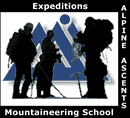Hello Mountain Zoners, the folks at MountainZone.com have asked us to send more information and updates from the Base Camp side of the climb, so over the next few weeks I'll be telling you everything you never wanted to know about Everest Base Camp. And there's lots to tell.
While Base Camp isn't as "glamorous" as a summit climb of Everest, it is a magical place in its own right, with hundreds of colorful tents, a canopy of waving prayer flags, and 360-degree views of spectacular mountains and glaciers. While Base Camp is only the jumping off place for the climbing team, it is the final destination for the hundreds of trekkers who arrive here each season.
At 17,600 feet, Everest Base Camp is higher than any place in the continental U.S., and is the highest that most of the trekkers have ever been in their lives. They well deserve to wear their Everest Base Camp/Kala Pattar (a nearby hill with spectacular views) T-shirts after completing this trek. I always say trekking in Nepal is like climbing anywhere else.
When trekkers arrive in Base Camp they aren't sure what to expect and are sometimes a little confused by what they see. Here's why. Everest Base Camp is located on the active ice of the Khumbu Glacier. From the time hikers drop off the steep lateral moraine (huge piles of rock and rubble deposited alongside as the glacier melts) about an hour before Base Camp they are walking on rubble covered glacier ice.
A glacier is like a huge moving river of ice, and there are no permanent buildings or structures at Base Camp because the movement of the glacier would destroy the foundations. We can't actually see the glacier moving, but it frequently "talks" to us with pops, cracks, and groans as the ice changes. From season to season Base Camp is always in the same place on the glacier, but the location of the camps is always a little bit different because we have to build from scratch at the beginning of each season.
So if there are no buildings, what is here? The answer is tents. This season we estimate there are between 300 and 500 tents in Base Camp, which is less than in most years (because of the economy, fear of traveling, who knows?). Most of the tents are smaller two-person dome tents for sleeping, and each camp usually has one or two larger tents for dining and storage. The closest thing to "permanent" buildings that we have are the cook "tents."
A team of Sherpas from each expedition usually comes early in the season to construct "buildings" with rock walls and tarps for roofs. Inside they use rocks to build cooking platforms, a long central table, and benches for sitting. These cook tents are warm and cozy when the stoves are running, and full of joking, singing, and laughing when people are gathered inside. Unfortunately, toward the end of the season we have to do a lot of rebuilding of the walls as the glacier movement and melting ice shift them around. By the next season they have all fallen down and are gone, and we have to build all over again.
Base Camp is laid out in a haphazard fashion. There are no "streets," just paths worn from camp to camp, and none of them is straight. Each expedition chooses an area to set up their tents, and moves in. By the time the season really gets going there is a more crowded "downtown" section, with less densely populated "suburb" areas around the edges. Our Alpine Ascents camp is located "uptown" towards the Khumbu Icefall, right on the edge of camp. Word has it that when Base Camp is in full swing it is the largest town in the Khumbu above Namche Bazaar.
So that's what Base Camp looks like. In a future report I'll give you a tour of our own Alpine Ascents International camp.
Namaste,
— Ellie Henke Alpine Ascents International Base Camp Manager and MountainZone.com Correspondent
 EMAIL THIS STORY TO A FRIEND
EMAIL THIS STORY TO A FRIEND




